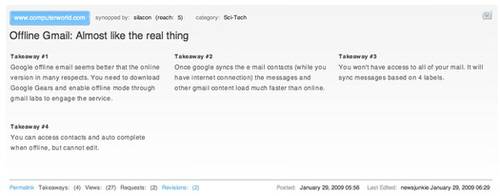Tagging. It has fundamentally changed the way we find and manage content on the Web. Take a page, an image, or a chunk of media, surround it with keywords, and allow others to do the same. Then mix that tagged content with more tagged content and suddenly context starts to form. But tagging, for all its benefits, will only get you so far. Between tagging and the content, there’s the opportunity for another level of classification – brief summaries of content. And that’s where Synop.it hopes to find its niche.

While Synop.it’s workflow is similar to social bookmarking – find a site and add it to a repository for future reference – the level of detail is quite different. Synop.it doesn’t allow the user to tag content. Rather, it offers the opportunity to provide the next level of detail – a short summary of the content.
Yes, it’s similar to the “summary” area provided by most social bookmarking sites. But as we all know, that’s an area that very few users take the time to complete – or they choose to fill the area with the first sentence of the content being saved. It’s rarely a summary.
Synop.it is designed expressly to capture those summaries, encouraging contributors to distill the content in a way that gives the reader context for the story as a whole. And if they find a summary that doesn’t do the article justice, they’re encouraged to help revise it. It’s like the wiki way meets social bookmarking.

As far as drawbacks go, there’s no way to judge the how one “takeaway” compares to another. Without a voting mechanism or ranking, readers may struggle to find the best summaries of content. But, users can deduce some of that information based on how many times the summary has been revised – and who has done the revising. And if the service develops a following of regular users, the on-going curation of the takeaways may make this a non-issue.
As a new service, Synop.it is still sparse in terms of content. But there’s a great deal of potential here for beginning to catalogue the Web in a way that directly complements the activities of millions of social bookmark contributors. More importantly, it’s an opportunity for a different kind of cataloguing that – when used in combination with other types of categorizing – can provide semantic clues for us to better understand the information around us.
If you’re interested in reading some of the synopses or trying your hand at distilling Web content into a short paragraph, give Synop.it a try. Getting started is as easy as registering and adding a bookmarklet to your browser.










